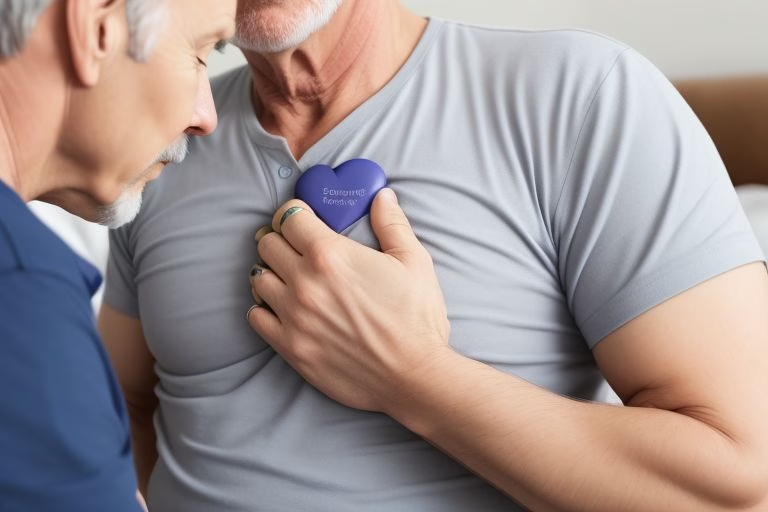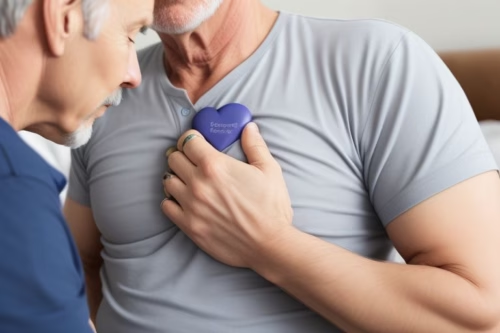
When it comes to taking care of our hearts, being aware of heart arrest symptoms can make a world of difference. In this article, we’ll explore 7 life-saving tips that can help you recognize early warning signs of heart trouble and empower you to take proactive steps toward a healthier life. Whether you’re a busy parent, an active professional, or just someone who cares about their well-being, understanding these symptoms and acting fast can definately save lives. Read on to discover how simple changes and the right knowledge can help you stay on top of your heart health.
Understanding Heart Arrest Symptoms
Before diving into the 7 essential tips, it’s important to understand what we mean by heart arrest symptoms. While many people often confuse a heart attack with cardiac arrest, they are two very different things. A heart attack is usually caused by a blockage in the blood vessels that supply your heart, while cardiac arrest happens when the heart suddenly stops pumping blood due to an electrical malfunction. Both conditions are serious, but knowing the subtle differences and warning signs can help you get the right help at the right time.
Heart arrest symptoms can include a variety of signs such as:
- Chest pain or discomfort: This might feel like pressure, squeezing, or fullness.
- Shortness of breath: Even when you’re at rest, struggling to breathe is a red flag.
- Palpitations: Your heart might feel like it’s racing or skipping beats.
- Dizziness or light-headedness: Feeling faint or unsteady can be a sign something is wrong.
- Sudden collapse or loss of consciousness: This is a critical warning sign and needs immediate attention.
For further detailed information on these symptoms, reputable resources like Mayo Clinic and the American Heart Association provide comprehensive guides.

Tip #1: Know the Common and Subtle Signs
The first step in protecting your heart health is to become familiar with both the common and subtle heart arrest symptoms. While the dramatic signs like sudden collapse and severe chest pain often grab our attention, subtle symptoms can sometimes be easily ignored or mistaken for less serious conditions like indigestion or fatigue.
For example, you might experience:
- Unexplained fatigue or weakness that just doesn’t go away.
- Mild chest discomfort that you attribute to stress or overexertion.
- Occasional dizziness, which might seem like just a momentary lapse in concentration.
It is vital not to dismiss these signs—even if they seem minor. Even slight discomfort may be your body’s way of trying to tell you that something isn’t quite right. Regularly check in with how you feel and if you notice any changes, be sure to consult your healthcare provider.
Tip #2: Monitor Your Heart Health Regularly
Regular check-ups are key to maintaining good heart health. Routine screenings, such as blood pressure measurements, cholesterol checks, and even an ECG, can help detect potential issues before they become serious. If you have a family history of heart disease or any risk factors (like high blood pressure or diabetes), it’s even more important to keep a close eye on your heart.
A simple visit to your doctor can help assess whether you’re at risk of developing conditions that lead to cardiac arrest. Many clinics offer free or low-cost screening programs, and websites like Cleveland Clinic provide valuable insights on what tests you might need.
Tip #3: Adopt a Heart-Healthy Lifestyle
There is no substitute for a healthy lifestyle when it comes to protecting your heart. By adopting a heart-healthy lifestyle, you can greatly reduce the risk of experiencing severe heart arrest symptoms. Here are some lifestyle changes you can start today:
- Eat a balanced diet: Focus on whole grains, lean proteins, fruits, and vegetables. Avoid excessive salt, sugar, and trans fats.
- Exercise regularly: Aim for at least 150 minutes of moderate aerobic activity per week. Even a brisk daily walk can make a huge difference.
- Quit smoking: Smoking is one of the biggest risk factors for heart disease. If you smoke, seek help to quit—it’ll improve your heart function and overall well-being.
- Limit alcohol consumption: Excessive alcohol can raise blood pressure and contribute to heart problems.
- Manage stress: Chronic stress can have a negative impact on your heart. Try relaxation techniques such as meditation, yoga, or even simple deep-breathing exercises.
Making these changes may seem challenging at first, but small, consistent steps can lead to big improvements in your heart health over time. For more tips on healthy eating and exercise, check out resources from the National Heart, Lung, and Blood Institute (NHLBI).
Tip #4: Understand Your Family History
Knowing your family’s medical history is crucial in predicting your own risk of heart disease and related complications. If your parents or close relatives have had heart disease or have experienced heart arrest symptoms, you might be at a higher risk.
Be proactive:
- Ask your relatives about any heart conditions they have experienced.
- Discuss this information with your doctor, who may recommend earlier or more frequent screenings.
- Use online risk calculators, such as QRISK, to better understand your personal risk factors.
This knowledge can empower you to take preventive measures and potentially catch problems before they escalate into a life-threatening situation.
Tip #5: Learn the Difference Between a Heart Attack and Cardiac Arrest
Many people mistakenly use the terms “heart attack” and “cardiac arrest” interchangeably, but they are not the same. Understanding the difference can be lifesaving.
- Heart Attack: Occurs when blood flow to a part of the heart is blocked. It might cause severe chest pain and discomfort, but the heart is still beating.
- Cardiac Arrest: Happens when the heart’s electrical system malfunctions, leading to an immediate stop in heart function. This can cause a person to lose consciousness very quickly.
Knowing these differences is crucial. For instance, if someone is experiencing a heart attack, they might still be able to speak and respond, whereas cardiac arrest is often sudden and dramatic. Learning first aid and CPR techniques can help you respond appropriately in an emergency. Consider taking a CPR course from organizations like the American Red Cross or the American Heart Association.
Tip #6: Be Prepared with a First Aid Plan
Emergencies don’t wait, and neither should you. Have a plan in place in case you or someone around you experiences heart arrest symptoms. This plan should include:
- Knowing the emergency number: In many countries, that’s 911. Make sure everyone in your household knows this number.
- Learning CPR: High-quality CPR can be the difference between life and death. Many people who experience cardiac arrest survive if CPR is started immediately.
- Locating an Automated External Defibrillator (AED): AEDs are often available in public places like malls, airports, and sports facilities. Familiarize yourself with the locations of AEDs in your area.
- Keeping a first aid kit: While a first aid kit can’t treat a heart emergency, having basic supplies on hand is part of being prepared.
Creating a safety net through education and preparation can reduce panic during an emergency. For more practical advice, check out CPR guidelines from the American Heart Association.
Tip #7: Listen to Your Body and Don’t Delay Medical Help
Sometimes, even if you’re leading a healthy lifestyle and are generally careful, your body might still send you warning signs. It’s important to listen to your body—even if you think you’re just tired or stressed. If you notice any heart arrest symptoms, no matter how minor they might seem, seek medical advice immediately.
Here are some situations where you should act fast:
- If you experience sudden chest pain or discomfort, especially if it radiates to your arm, neck, or jaw.
- If you feel dizzy, light-headed, or extremely fatigued for no apparent reason.
- If you have episodes of rapid or irregular heartbeats.
- If you suddenly lose consciousness or collapse.
Do not try to self-diagnose or wait for the symptoms to go away. Early intervention can make a significant difference in outcomes. A timely response, such as calling an ambulance immediately, could very well save your life.
Taking Action: What to Do if You Spot Heart Arrest Symptoms
When you or someone around you shows signs of a possible heart emergency, acting quickly is vital. Here’s what you should do:
- Call for Help Immediately: If you suspect someone is experiencing cardiac arrest, dial your local emergency number (like 911 in the U.S.). Don’t waste any time!
- Start CPR Right Away: If you’re trained in CPR, begin chest compressions immediately. Even if you’re not certified, many simple CPR techniques can be learned online.
- Locate an AED: If an Automated External Defibrillator is available nearby, use it as soon as possible. AEDs are designed for untrained bystanders and provide clear instructions.
- Follow Emergency Protocols: Continue with CPR and follow any instructions provided by emergency services until help arrives.
The American Heart Association recommends that every minute without CPR decreases the chance of survival by about 10%. That’s why it’s so crucial to know the steps and act decisively. For more detailed steps, check out this CPR guide from Cleveland Clinic.
Real-Life Stories: Learning from Others
Real-life stories can be powerful reminders of why it’s so important to know your heart arrest symptoms and act quickly. Consider the case of a mum-of-two from Norfolk who tragically died while waiting for an ambulance. Her story, which was widely reported by sources like the Scottish Sun, underlines how delays in treatment can have devastating consequences.
Another inspiring story comes from individuals who survived cardiac arrest due to the immediate action of bystanders trained in CPR. These cases highlight that while cardiac events are terrifying, being prepared and informed can dramatically increase survival rates. Reading such stories can motivate you to take charge of your own health and possibly even learn lifesaving techniques yourself.
The Role of Technology and Innovation
Advances in medical technology have made it easier than ever to monitor heart health. Many wearable devices can now track heart rate, blood pressure, and even detect irregularities that could indicate dangerous heart arrest symptoms. Smartwatches and fitness trackers are becoming popular tools for early detection. While these devices aren’t a substitute for professional medical advice, they can serve as an early warning system.
For example, some smartwatches can alert users if they detect an irregular heartbeat, prompting them to seek medical evaluation. This technology has the potential to catch problems before they become severe, giving you a chance to make lifestyle changes or seek early treatment. For more about wearable heart health tech, visit MedlinePlus.
Making the Right Diet Choices
A heart-healthy diet is fundamental in preventing conditions that lead to severe heart arrest symptoms. Incorporate foods that are rich in nutrients, antioxidants, and healthy fats. Here are a few dietary tips to consider:
- Fruits and Vegetables: Aim for a rainbow of colors in your diet. These provide essential vitamins and antioxidants that help reduce inflammation.
- Whole Grains: Foods like oats, brown rice, and whole wheat are excellent sources of fiber and can help maintain healthy cholesterol levels.
- Lean Proteins: Include sources like chicken, fish, and plant-based proteins. Fish, especially, is rich in omega-3 fatty acids which are known to support heart health.
- Healthy Fats: Use olive oil, avocado, and nuts as healthy fat sources. Avoid trans fats and limit saturated fats as much as possible.
- Limit Processed Foods: Highly processed foods often contain excessive salt, sugar, and unhealthy fats that can contribute to high blood pressure and other heart issues.
Remember, dietary changes don’t have to be drastic. Even small, sustainable changes can lead to big improvements in your overall heart health. For more nutrition advice, check out the guidelines provided by the National Heart, Lung, and Blood Institute.
Exercise: The Natural Heart Booster
Regular physical activity is one of the most effective ways to protect your heart. Exercise helps strengthen the heart muscle, improves blood circulation, and reduces stress—all of which lower your risk of experiencing dangerous heart arrest symptoms. Whether it’s a daily walk, a bike ride, or a dance class, any movement is beneficial.
Here are some exercise tips:
- Start Slow: If you’re new to exercise, begin with low-impact activities and gradually increase your intensity.
- Mix It Up: Combine cardiovascular exercise with strength training and flexibility exercises.
- Stay Consistent: Aim for at least 30 minutes of exercise most days of the week.
- Listen to Your Body: Don’t push yourself too hard—if you feel pain or extreme fatigue, take a break.
Even if you have a busy schedule, try to incorporate movement into your day. Take the stairs instead of the elevator, walk during your lunch break, or even do a quick set of exercises at home. Remember, every little bit helps when it comes to maintaining your heart health.
Managing Stress for a Healthier Heart
Chronic stress can have a significant impact on your heart. Stress hormones can raise your blood pressure, lead to unhealthy habits, and even contribute to weight gain. Learning to manage stress is an essential component of preventing heart issues and recognizing heart arrest symptoms before they become critical.
Consider these stress-management techniques:
- Mindfulness and Meditation: These practices can help calm your mind and reduce stress levels.
- Deep Breathing Exercises: Even a few minutes of deep breathing can help lower your heart rate and blood pressure.
- Regular Physical Activity: As mentioned earlier, exercise is a great stress reliever.
- Social Connections: Spending time with loved ones and maintaining strong relationships can provide emotional support.
- Professional Help: If stress becomes overwhelming, consider talking to a therapist or counselor.
Finding what works for you is key. Everyone’s stress triggers are different, so it’s important to experiment with different techniques until you find the best fit for your lifestyle.
The Importance of Sleep
Quality sleep is another critical factor in maintaining good heart health. Poor sleep can lead to a variety of health problems, including high blood pressure and an increased risk of heart disease. It can also mask or exacerbate heart arrest symptoms if your body doesn’t have enough time to recover and repair itself.
Try to:
- Maintain a Consistent Sleep Schedule: Go to bed and wake up at the same time every day.
- Create a Relaxing Environment: Keep your bedroom dark, cool, and quiet.
- Avoid Screens Before Bed: The blue light emitted by phones and computers can interfere with your sleep cycle.
- Practice Relaxation Techniques: Reading, listening to calming music, or meditating before bed can help improve sleep quality.
By prioritizing sleep, you not only boost your overall well-being but also reduce the risk of developing serious heart conditions.
Embracing Regular Medical Check-Ups
Even if you feel healthy, regular medical check-ups are vital. They help catch potential issues early, especially if you’re at higher risk due to family history or lifestyle factors. Doctors can perform tests like ECGs and stress tests to detect early signs of heart disease.
Make it a habit to:
- Schedule Annual Physicals: Regular visits to your healthcare provider can monitor your heart’s function and overall health.
- Follow Through on Recommended Tests: Don’t skip out on blood tests or imaging studies that can provide crucial insights.
- Discuss Any Symptoms: Even if you think it might just be stress or fatigue, mention any unusual symptoms to your doctor.
These proactive steps can lead to early intervention and treatment, potentially preventing a major cardiac event.
Real-Life Inspirations and Success Stories
Nothing motivates like real-life success stories. There are numerous examples of individuals who recognized heart arrest symptoms early and took action, which not only saved their lives but also inspired others to become more vigilant about their heart health.
For instance, stories covered by outlets like People and The Times illustrate how timely CPR and medical intervention helped survivors bounce back from what could have been fatal events. These narratives remind us that knowledge and preparation truly are power. Even if you’ve had moments where you felt something wasn’t right with your heart, these examples show that it’s never too late to seek help and change your life for the better.
Final Thoughts: Your Heart, Your Life
Our hearts are at the center of everything we do—without them, life as we know it wouldn’t be possible. Recognizing heart arrest symptoms early and taking the necessary steps to maintain a healthy lifestyle are among the best investments you can make in your future. While no one likes to think about emergencies, being prepared means you can act swiftly when needed and potentially save a life—whether it’s your own or someone else’s.
Remember:
- Stay informed: Knowledge about heart arrest symptoms can empower you to act quickly.
- Be proactive: Regular check-ups, a balanced diet, exercise, and stress management are your best tools.
- Take action immediately: If you experience any warning signs, don’t wait—seek help immediately



